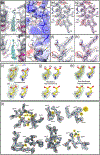CryoEM maps are full of potential
- PMID: 31400843
- PMCID: PMC6778505
- DOI: 10.1016/j.sbi.2019.04.006
CryoEM maps are full of potential
Abstract
Electron microscopy is based on elastic scattering due to Coulomb forces between the incident electrons and the sample; thus, electron scattering is dependent on the charge distribution in the sample. Unlike atomic scattering factors for X-rays, electron scattering factors for some atoms are strongly dependent on scattering angle, and the scattering factor for ionic oxygen is negative at low scattering angle. This phenomenon can result in a significant negative contribution to Coulomb potential maps by oxygen and can result in deviations in the positions of positive map features from atomic centers. An important factor that can also complicate the interpretation of cryoEM maps is the exquisite sensitivity of macromolecules to damage from electron irradiation, especially the carboxylates of acidic amino acids. Ideally, when compared with electron density maps derived by X-ray crystallography, Coulomb potential maps can provide additional details about the electrostatic environment and charge state of atoms. Enhancements in model building, refinement and computational simulation will be required to realize the full potential of EM-derived maps to reveal deeper insight into the electronic structure and functional properties of macromolecular complexes and their interactions with binding partners, ligands, cofactors, and drugs.
Copyright © 2019 Elsevier Ltd. All rights reserved.
Conflict of interest statement
Author disclosures
The authors declare no conflicts of interest.
No conflict of interest exists.
We wish to confirm that there are no known conflicts of interest associated with this publication and there has been no significant financial support for this work that could have influenced its outcome.
Figures





References
-
-
Henderson R: The potential and limitations of neutrons, electrons and X-rays for atomic resolution microscopy of unstained biological molecules. Q Rev Biophys 1995, 28:171193.
• It is impossible to overstate Richard Henderson’s contributions to the field of structural biology and to the larger scientific community. This review provides an excellent background to imaging of macromolecules with different radiation sources and a view from the past into the present.
-
-
-
Vinothkumar KR, Henderson R: Single particle electron cryomicroscopy: trends, issues and future perspective. Q Rev Biophys 2016, 49:e13.
• An excellent overview of the current state of cryoEM and future challenges and opportunities.
-
-
-
Wang J, Moore PB: On the interpretation of electron microscopic maps of biological macromolecules. Protein Sci 2017, 26:122–129.
•• This paper and two others by Jimin Wang in the same issue of Protein Science present in depth discussions and analysis of the fundamental nature of Coulomb potential maps and current issues and shortcomings in the use of these maps for structure modeling.
-
-
- Fischer N, Neumann P, Konevega AL, Bock LV, Ficner R, Rodnina MV, Stark H: Structure of the E. coli ribosome-EF-Tu complex at <3 A resolution by Cs-corrected cryo-EM. Nature 2015, 520:567–570. - PubMed
Publication types
MeSH terms
Substances
Grants and funding
LinkOut - more resources
Full Text Sources

